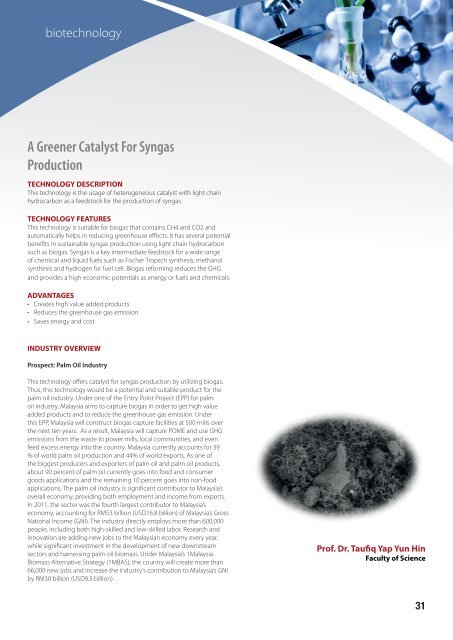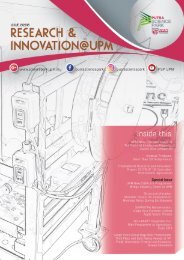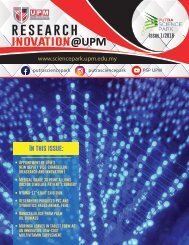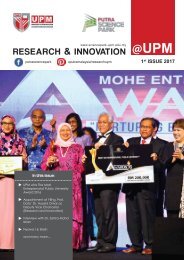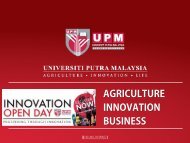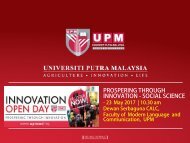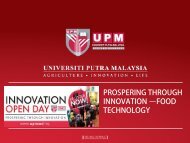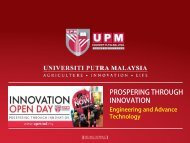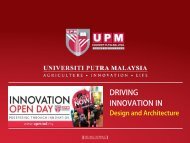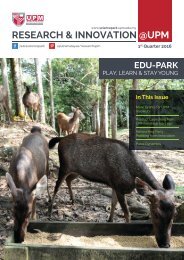Innovation directory 4th edition
Create successful ePaper yourself
Turn your PDF publications into a flip-book with our unique Google optimized e-Paper software.
iotechnology<br />
A Greener Catalyst For Syngas<br />
Production<br />
TECHNOLOGY DESCRIPTION<br />
This technology is the usage of heterogeneous catalyst with light chain<br />
hydrocarbon as a feedstock for the production of syngas.<br />
TECHNOLOGY FEATURES<br />
This technology is suitable for biogas that contains CH4 and CO2 and<br />
automatically helps in reducing greenhouse effects. It has several potential<br />
benefits in sustainable syngas production using light chain hydrocarbon<br />
such as biogas. Syngas is a key intermediate feedstock for a wide range<br />
of chemical and liquid fuels such as Fischer Tropsch synthesis, methanol<br />
synthesis and hydrogen for fuel cell. Biogas reforming reduces the GHG<br />
and provides a high economic potentials as energy or fuels and chemicals.<br />
ADVANTAGES<br />
• Creates high value added products<br />
• Reduces the greenhouse gas emission<br />
• Saves energy and cost<br />
INDUSTRY OVERVIEW<br />
Prospect: Palm Oil Industry<br />
This technology offers catalyst for syngas production by utilizing biogas.<br />
Thus, this technology would be a potential and suitable product for the<br />
palm oil industry. Under one of the Entry Point Project (EPP) for palm<br />
oil industry, Malaysia aims to capture biogas in order to get high value<br />
added products and to reduce the greenhouse gas emission. Under<br />
this EPP, Malaysia will construct biogas capture facilities at 500 mills over<br />
the next ten years. As a result, Malaysia will capture POME and use GHG<br />
emissions from the waste to power mills, local communities, and even<br />
feed excess energy into the country. Malaysia currently accounts for 39<br />
% of world palm oil production and 44% of world exports. As one of<br />
the biggest producers and exporters of palm oil and palm oil products,<br />
about 90 percent of palm oil currently goes into food and consumer<br />
goods applications and the remaining 10 percent goes into non-food<br />
applications. The palm oil industry is significant contributor to Malaysia’s<br />
overall economy, providing both employment and income from exports.<br />
In 2011, the sector was the fourth largest contributor to Malaysia’s<br />
economy, accounting for RM53 billion (USD16.8 billion) of Malaysia’s Gross<br />
National Income (GNI). The industry directly employs more than 600,000<br />
people, including both high-skilled and low-skilled labor. Research and<br />
innovation are adding new jobs to the Malaysian economy every year,<br />
while significant investment in the development of new downstream<br />
sectors and harnessing palm oil biomass. Under Malaysia’s 1Malaysia<br />
Biomass Alternative Strategy (1MBAS), the country will create more than<br />
66,000 new jobs and increase the industry’s contribution to Malaysia’s GNI<br />
by RM30 billion (USD9.5 billion).<br />
Prof. Dr. Taufiq Yap Yun Hin<br />
Faculty of Science<br />
31


